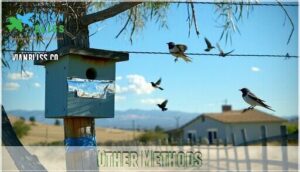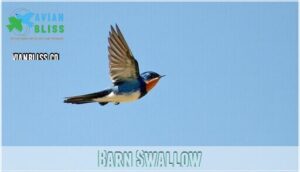This site is supported by our readers. We may earn a commission, at no cost to you, if you purchase through links.

These aerial acrobats build their mud nests under bridges, in barns, and along cliffs, creating colonies that can house hundreds of pairs. Tree Swallows prefer nest boxes, while Bank Swallows tunnel into riverbanks.
Purple Martins, the largest swallows in California, seek out apartment-style housing. Each species has distinct nesting habits, flight patterns, and preferred habitats that make identification easier once you know what to look for.
Understanding their biology and legal protections becomes essential when these birds choose your property as home.
Table Of Contents
- Key Takeaways
- Identification and Biology
- Management
- Bank Swallow
- Barn Swallow
- Cave Swallow (Rare)
- Cliff Swallow
- Northern Rough-winged Swallow
- Purple Martin
- Tree Swallow
- Violet-green Swallow
- Frequently Asked Questions (FAQs)
- What are the famous swallows in California?
- Do the swallows still return to Capistrano every year?
- Are swallows good to have around your house?
- What time of year do swallows migrate?
- How long do swallows typically live?
- What predators threaten swallows and their nests?
- Do swallows return to same nesting sites?
- How can I attract swallows to my property?
- Conclusion
Key Takeaways
- You’ll find eight distinct swallow species across California – from common Barn Swallows in farmlands to rare Cave Swallows, each with unique nesting habits, flight patterns, and preferred habitats that make identification straightforward once you know what to look for.
- Federal law protects all swallows under the Migratory Bird Treaty Act – you cannot remove active nests without permits, but you can legally remove inactive nests outside the February-September breeding season and install exclusion barriers during non-breeding months.
- These aerial acrobats are natural pest controllers – they devour thousands of flying insects daily, including mosquitoes and flies, making them beneficial neighbors despite potential nesting conflicts around your property.
- Timing is everything for swallow management – install deterrents between October and February when birds migrate south, use nest boxes to redirect nesting away from problem areas, and apply exclusion methods before the breeding season begins.
Identification and Biology
You’ll encounter eight distinct swallow species across California, each with unique physical features and behaviors that make identification straightforward once you know what to look for.
Understanding their biology—from nesting preferences to feeding patterns—helps you distinguish between species and manage any potential conflicts around your property, which is crucial for identification.
Distribution and Habitat
California’s eight swallow species showcase remarkable geographic range diversity across varied habitat types.
From coastal cliffs to mountain meadows, these California birds demonstrate clear niche partitioning based on elevation preferences and climate influence.
Swallow habitats span wetlands, agricultural areas, and urban environments, with each species claiming distinct territories.
California wildlife benefits from this specialization, as different swallows exploit unique food sources and nesting opportunities across the state’s diverse bird habitats in California.
Site Selection
Selecting the perfect nesting sites involves careful consideration of habitat preference and site fidelity.
You’ll find swallows choosing locations based on species-specific needs: Barn Swallows favor sheltered spots on manmade structures like barns and garages, while Cliff Swallows form massive colonies under eaves with ideal colony size reaching hundreds of pairs.
Tree Swallows seek cavities in dead trees or nest boxes, showing strong nest reuse patterns.
Northern Rough-winged Swallows prefer solitary nesting sites in riverbanks or culverts, contrasting sharply with their colonial cousins’ nesting behaviors, and exhibiting a preference for solitary nesting sites.
Nest Construction
Swallows transform simple nest materials like mud pellets, grass, and feathers into architectural marvels.
They collect hundreds of tiny mud balls, methodically building their colony’s intricate structures under eaves and ledges.
Construction timing varies by species, with some reusing previous nests while others start fresh.
Their nesting behaviors showcase remarkable engineering skills, creating secure homes through careful nest placement and collaborative building efforts within their bustling communities.
They often use saliva as natural nest cement to build their secure homes with collaborative building efforts.
Egg Laying
Most swallow species follow predictable egg-laying patterns that’ll help you understand their nesting habits. During breeding season, females typically produce clutches containing 3-5 glossy eggs with delicate speckled patterns. Egg coloration ranges from pure white to pale blue, often decorated with brown or reddish spots that create unique fingerprints for each nest.
The incubation period lasts 12-16 days, depending on weather conditions and species. You’ll notice females spending most daylight hours warming their precious cargo while males patrol territories and gather insects.
Hatching success rates hover around 70-80% under normal conditions, though harsh weather can dramatically reduce these numbers. Parasitism effects from cowbirds occasionally threaten swallow reproduction, as these brood parasites slip their own eggs into unsuspecting nests.
However, most swallow species have evolved defensive behaviors that minimize this threat. Understanding these egg-laying fundamentals helps you appreciate the delicate balance these aerial acrobats maintain while raising their young in California’s diverse landscapes, which is crucial for their breeding season and overall survival, showcasing their ability to adapt to harsh weather conditions.
Nest Failures
Disaster strikes even the most carefully built homes.
Weather Effects like storms and cold snaps destroy fragile mud structures, while Predation Impacts from snakes and jays threaten bird eggs and chicks.
Human Disturbance from construction noise disrupts nest construction, and Parasite Infestation weakens adults.
When nest failures occur, determined parents quickly rebuild and restart egg laying, turning setbacks into comebacks.
Management
Managing swallows around your property requires understanding federal protections and using the right timing and techniques.
You’ll need to balance legal compliance with practical solutions to prevent nesting conflicts while respecting these beneficial insect-eating birds.
Legal Status and Permit Requirements
Understanding legal status and permit requirements protects you from hefty fines while managing swallows responsibly.
California’s Migratory Bird Treaty Act protection means you can’t touch active nests without federal permits from U.S. Fish and Wildlife Service.
However, inactive nests outside February-September breeding season don’t require permits for removal, giving you flexibility for mitigation measures; this is especially important because the San Diego nesting season typically runs from March to September.
Nest Removal
Timing your nest removal correctly protects both you and the birds from legal trouble.
Once you’ve secured proper bird permits, act swiftly during non-breeding seasons when nests sit empty.
- Safety first: Wear protective gear including gloves, eye protection, and masks to avoid parasites
- Permit justification: Document health or safety hazards like doorway blockages for removal authorization
- Alternative solutions: Consider nest relocation to nearby suitable sites before complete removal
Remove hardened mud using hammers, chisels, or pressure washers on low settings.
Clean all remnants thoroughly—leftover traces attract returning birds.
Apply bird deterrents immediately after removal to prevent rebuilding attempts.
Exclusion
Property owners can achieve successful bird control through strategic exclusion methods that protect both swallows California and structures.
Professional services install effective barriers like netting and mesh during non-breeding seasons, ensuring legal compliance under federal protections.
| Exclusion Method | Effectiveness & Cost |
|---|---|
| Physical Barriers | 90% success, moderate investment |
| Deterrent Materials | 70% success, low-cost option |
| Professional Services | 95+ success, higher upfront cost |
Timing strategies prove vital—exclusion works best between October and February when birds migrate south.
Property owners can find netting for bird control to help manage swallows.
Avian exclusion techniques like reflective tape and bird spikes offer humane alternatives to nest removal.
Cost analysis shows professional installation prevents expensive cleanup cycles.
Smart property managers combine multiple deterrent materials for maximum effectiveness while respecting these protected aerial insectivores.
Other Methods
When conventional exclusion methods fall short, creative deterrent approaches can help redirect swallow activity without causing harm.
Consider these alternative strategies that work alongside traditional avian exclusion and nest removal techniques:
- Install nest boxes in alternative locations – Provide suitable nesting sites away from problem areas, giving swallows preferred alternative habitats while protecting your property.
- Deploy visual deterrents and deterrent sounds – Use reflective tape, predator decoys, and electronic distress calls to make areas less appealing for nesting without harming birds.
- Apply bird repellents strategically – Use methyl anthranilate-based products that create unpleasant scents, encouraging natural relocation while respecting legal protections.
These methods complement standard exclusion methods while acknowledging swallows’ protected status under federal law; remember that swallows exhibit strong homing instinct, returning to the same nesting locations each year.
Bank Swallow
Along California’s waterways, you’ll spot Bank Swallows with their distinctive grayish-brown backs and white undersides marked by dark chest bands. These swallows in California represent one of eight bird species in California that face serious conservation challenges.
Their colony dynamics involve hundreds of pairs working together, creating extensive underground networks that look like apartment complexes carved into cliffsides. Bank Swallows excel at burrow excavation, digging tunnels up to three feet deep in vertical sand or soil banks near streams and rivers.
Unfortunately, their conservation status has declined to near-threatened due to habitat loss from development and flood control projects. Insecticide impact further threatens their survival by reducing flying insect populations they depend on for food.
These aerial acrobats time their breeding with peak insect activity, typically nesting from May through July. For bird identification, look for their smaller size compared to other swallows and their preference for staying close to water sources.
Peak insect season equals perfect timing—swallows know exactly when to nest for maximum feeding success.
Bird habitats along California’s rivers and streams need protection to guarantee these remarkable diggers continue gracing our waterways with their swift, graceful flight patterns. To support these efforts, consider exploring options for enhancing swallow habitats.
Barn Swallow
You’ll recognize Barn Swallows by their navy blue backs and deeply forked tails swooping through California skies.
These aerial acrobats showcase remarkable foraging behavior, catching insects mid-flight with precision that’d make a fighter pilot jealous. Their social structure revolves around colonies, though they’re less gregarious than their cliff-dwelling cousins.
Key Barn Swallow characteristics in California:
- Plumage variations include rusty-orange throats and cream-colored undersides
- Barn swallow diet consists primarily of flies, beetles, and flying ants
- Nesting habits favor barn rafters and building eaves for mud-cup construction
- Conservation status remains stable across most California regions
These swallows in California represent one of our most adaptable bird species in California, making birdwatching in California rewarding for beginners and experts alike.
Cave Swallow (Rare)
Cave Swallows represent one of California’s rarest bird species, making every sighting a treasure for dedicated birders. You’ll find these elusive aerial acrobats in the state’s most remote desert canyons and rocky outcrops, where their chattering calls bounce off ancient stone walls.
Rarity Factors make Cave Swallow identification in California particularly challenging. Unlike their Texas cousins, California populations remain extremely limited, with Population Trends showing sporadic breeding records. Habitat Loss from development rarely affects these birds since they prefer inaccessible terrain that developers can’t reach.
| Characteristic | Cave Swallow | Barn Swallow |
|---|---|---|
| Tail Shape | Square-cut | Deeply forked |
| Face Color | Orangey-buff | Reddish-orange |
| Range | Very limited | Statewide |
Conservation Strategies focus on protecting remote breeding sites and monitoring Genetic Diversity within small populations. Watch for their gourd-shaped mud nests plastered inside caves or cliff crevices. Their squared-off tails and buff-colored faces distinguish them from more common swallow species. Climate change may affect insect availability in their desert habitats, making habitat protection increasingly important.
Cliff Swallow
Master builders of the bird world, cliff swallows turn California’s rugged landscapes into bustling neighborhoods.
You’ll spot these navy-blue beauties with their distinctive white foreheads and rusty-orange throats swooping around bridges, culverts, and yes—the famous Capistrano Swallows that made Mission San Juan Capistrano a household name.
These social architects don’t mess around in the matter of mud nesting. They’ll gather hundreds of mud pellets daily, crafting gourd-shaped homes that cluster together like apartment complexes.
Colony dynamics get interesting here—while most species mind their own business, cliff swallows practice brood parasitism, sneaking eggs into neighbors’ nests when nobody’s looking.
What’s really clever is their nest reuse strategy. Year after year, they’ll return to repair and renovate their mud masterpieces, creating multi-generational neighborhoods.
Their diet mainly consists of flying insects, caught with impressive aerial maneuvers. California birdwatching enthusiasts love these bird species for their acrobatic insect-hunting displays and their remarkable ability to turn any suitable overhang into a thriving community.
Northern Rough-winged Swallow
Unlike their colony-loving cousins, Northern Rough-winged Swallows prefer solitary nesting in California’s waterways. You’ll spot these brownish-gray swallow species gliding low over streams and ponds, their wing adaptations allowing precise maneuvers as they snatch insects from the surface.
This birdwatching California favorite gets its name from tiny hooks on its wing feathers—a unique feature among North American swallows. Their vocalizations consist of quiet rattles and buzzes, quite different from their chattering relatives.
These stream foraging specialists excavate tunnels in riverbanks or use existing cavities like old kingfisher burrows. Conservation status remains stable, though habitat loss affects local populations.
Their plumage is brownish-gray, and sex differentiation is subtle, making it hard to distinguish males from females. For your bird identification guide, look for their dusky throat and slightly notched tail.
They’re less social than other swallows, typically nesting as isolated pairs rather than large colonies. You’ll find them throughout California from March through September, raising two broods annually in their peaceful riverside territories.
Purple Martin
Purple Martins are California’s largest swallows, showcasing deep purple feathers that shimmer in sunlight.
Their Purple Martin Diet consists of flying insects caught during aerial acrobatics. Martin Migration brings them from South American wintering grounds each spring.
Successful Colony Management requires Predator Control around nest sites. Unlike other swallow species, Purple Martins east of the Rocky Mountains rely completely on human-provided housing, making your backyard boxes essential for their survival and breeding success, and they depend entirely on Martin Housing—apartment-style boxes and gourds you can install.
Tree Swallow
Through California’s open meadows and wetlands, you’ll spot Tree Swallows performing aerial acrobatics as they hunt flying insects. These cavity nesting birds arrive early each spring to claim prime real estate in natural cavities or nest boxes near water sources.
Tree Swallows face intense competition for suitable nesting sites, making nest boxes essential for their conservation efforts. Their insect diet consists primarily of flies, beetles, and flying ants, which they catch with remarkable precision during flight.
Key characteristics of Tree Swallows in California:
- Iridescent blue-green backs with pristine white undersides
- Clutch size typically ranges from 4-7 glossy white eggs
- Migration patterns take them south to Central America each winter
- Prefer open areas near ponds, marshes, and slow-moving streams
- Nest in old woodpecker holes or artificial nest boxes
- Feed exclusively on aerial insects during breeding season
- Return to California breeding grounds by late February
- Form loose colonies when suitable habitat is abundant
These swallows depend heavily on wetland preservation and nest box programs. Their declining numbers reflect habitat loss, making your conservation efforts indispensable for maintaining healthy populations across California’s diverse ecosystems.
Violet-green Swallow
You’ll spot the Violet-green Swallow’s metallic green back and violet-blue rump shimmering across California’s western woodlands and mountain meadows.
These agile birds nest in cliff crevices, tree cavities, and nest boxes, showing remarkable habitat preferences from sea level to 12,000 feet elevation.
Violetgreen Swallow plumage variation includes males with brighter iridescent coloring, while females display duller tones.
Their vocalizations consist of liquid twitter calls and chattering notes during social interactions.
You’ll observe their foraging behavior as they hawk insects mid-flight, often joining mixed-species flocks.
Like other birds, their coloration is influenced by melanin and carotenoids.
These swallows in California prefer open areas near water sources, making them excellent neighbors for homeowners.
Their nesting habits include using old woodpecker holes or artificial nest boxes.
Conservation status remains stable, though habitat loss affects some populations.
Watch for their acrobatic displays during breeding season when they’re most vocal and active.
Frequently Asked Questions (FAQs)
What are the famous swallows in California?
Celebrated cliff swallows at Mission San Juan Capistrano create California’s most cherished avian tradition.
You’ll witness their legendary March 19th return, transforming this historic site into a symbol of renewal and hope for countless visitors.
Do the swallows still return to Capistrano every year?
Yes, you can still witness the swallows returning to Capistrano annually, though their numbers have substantially dropped from historic peaks.
The Mission San Juan Capistrano celebrates this tradition every March 19th with bell ringing and community festivities.
Are swallows good to have around your house?
You’ll love having swallows around! They’re natural pest controllers, devouring thousands of flying insects daily, including mosquitoes and flies.
They’re fascinating to watch swooping gracefully through your yard, plus they’re protected songbirds that bring life to your property, making them a wonderful addition with their natural pest control abilities.
What time of year do swallows migrate?
Like clockwork, you’ll see swallows migrate south for winter from late summer through early fall, then return north for breeding season in spring, typically arriving between March and May.
How long do swallows typically live?
Swallows typically live 3-4 years in the wild, though some species can reach 8-10 years. You’ll find their lifespan varies by species, habitat quality, and predation pressure.
What predators threaten swallows and their nests?
Unfortunately, snakes, raccoons, cats, bullfrogs, and rats threaten your swallows’ eggs and hatchlings, while hawks, gulls, and grackles target nests. These feathered friends face nature’s harsh realities daily.
Do swallows return to same nesting sites?
Yes, you’ll notice swallows often return to the same nesting sites year after year.
They reuse and repair their mud nests annually, with cliff swallows particularly faithful to established colony locations.
How can I attract swallows to my property?
Create comfortable conditions by providing water sources, installing nest boxes, and maintaining open areas for insect hunting.
You’ll boost your chances by offering mud puddles for nest construction and avoiding pesticides that eliminate their food supply.
Conclusion
Like tiny feathered architects painting the sky with their acrobatics, swallows in California offer both wonder and management challenges.
You’ve learned to identify all eight species through their unique nesting habits, flight patterns, and preferred habitats.
Remember that federal protection requires careful timing for any nest removal or exclusion efforts.
Whether you’re welcoming these beneficial insect-eaters or managing their presence on your property, understanding their biology helps you make informed decisions.
With proper identification and legal compliance, you can successfully coexist with these remarkable aerial performers throughout California’s diverse landscapes.
- https://ipm.ucanr.edu/home-and-landscape/cliff-swallows/pest-notes/
- https://sitesproject.org/wp-content/uploads/2023/11/Garrison_1998_Bank-Swallow-Riparia-riparia-Species-Account.pdf
- https://nrm.dfg.ca.gov/FileHandler.ashx?DocumentID=2945
- https://en.wikipedia.org/wiki/Cliff_swallow
- https://sora.unm.edu/sites/default/files/journals/condor/v060n01/p0007-p0037.pdf
















